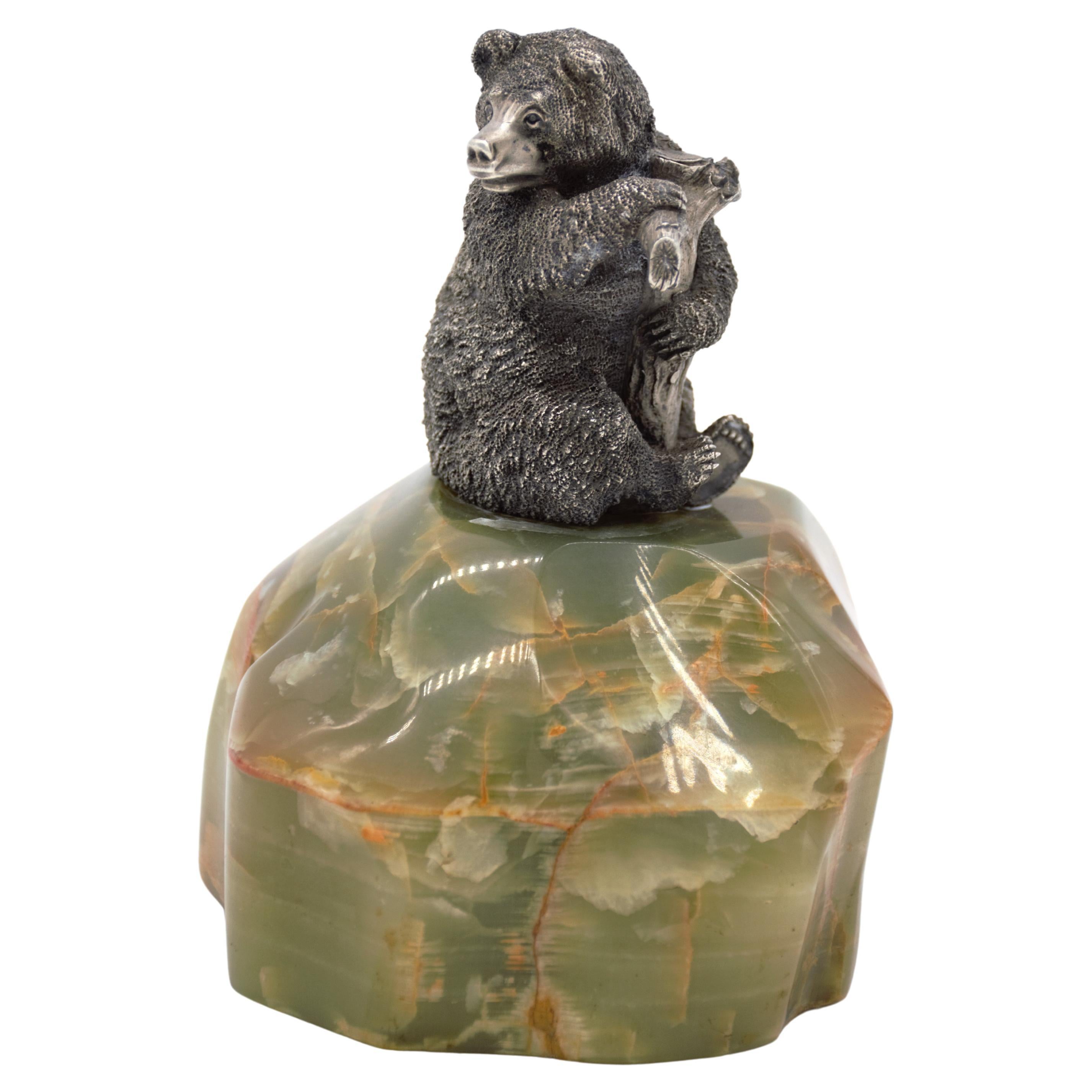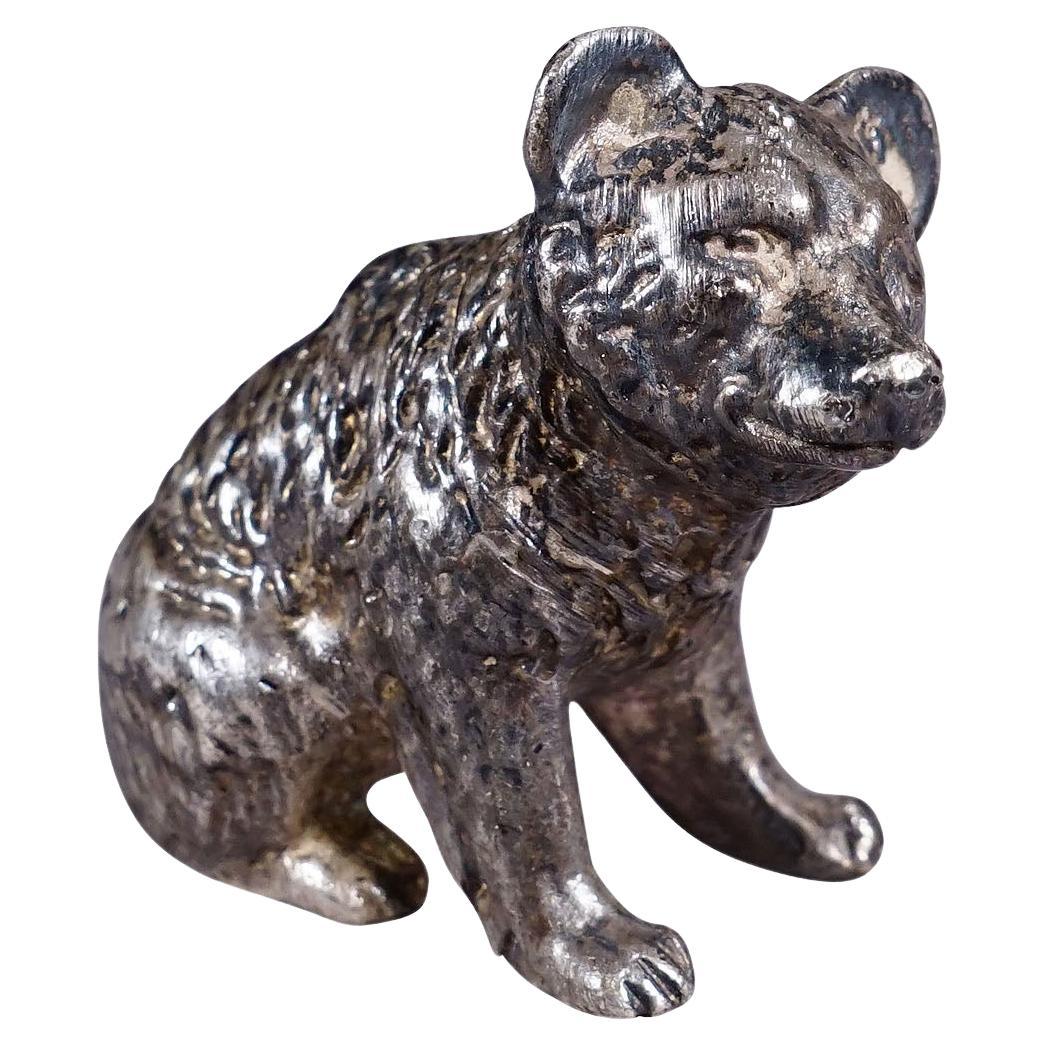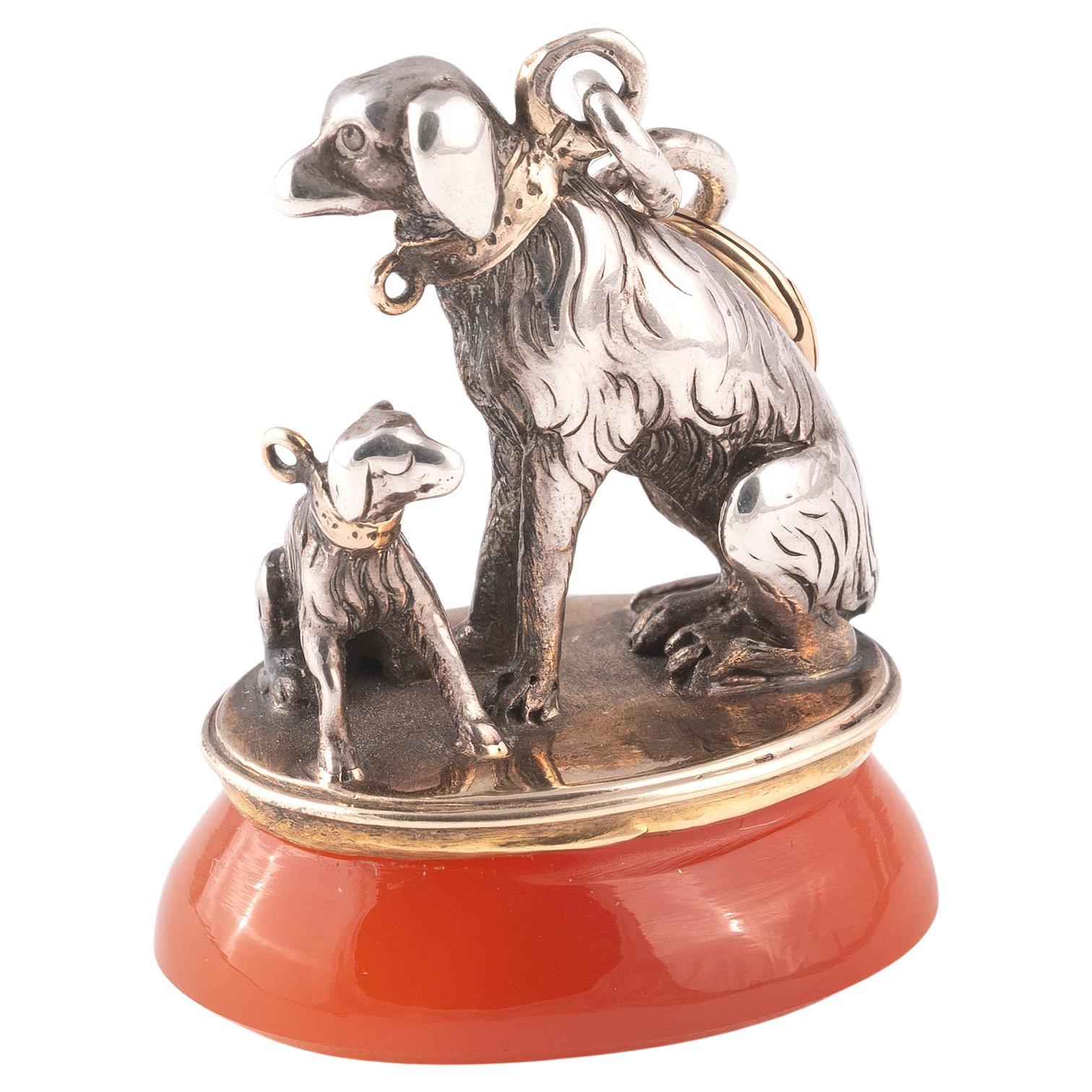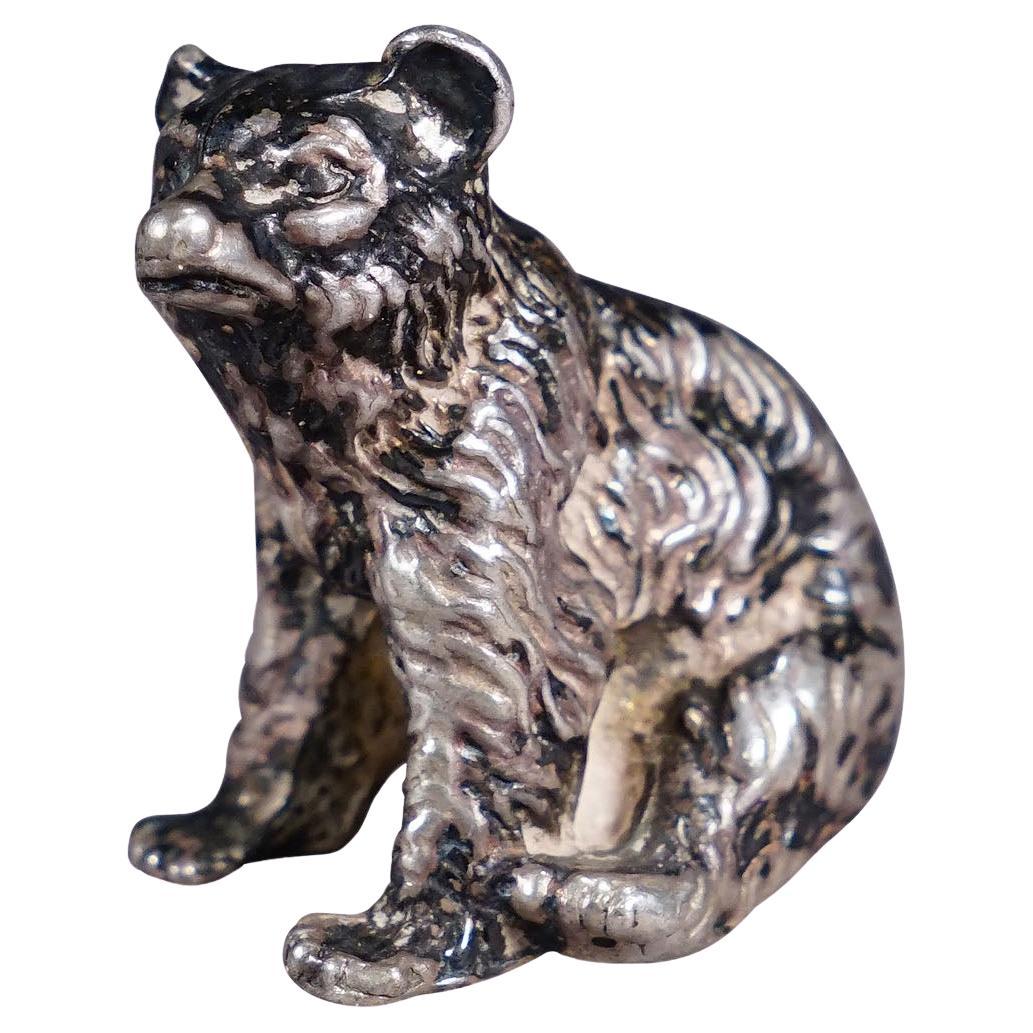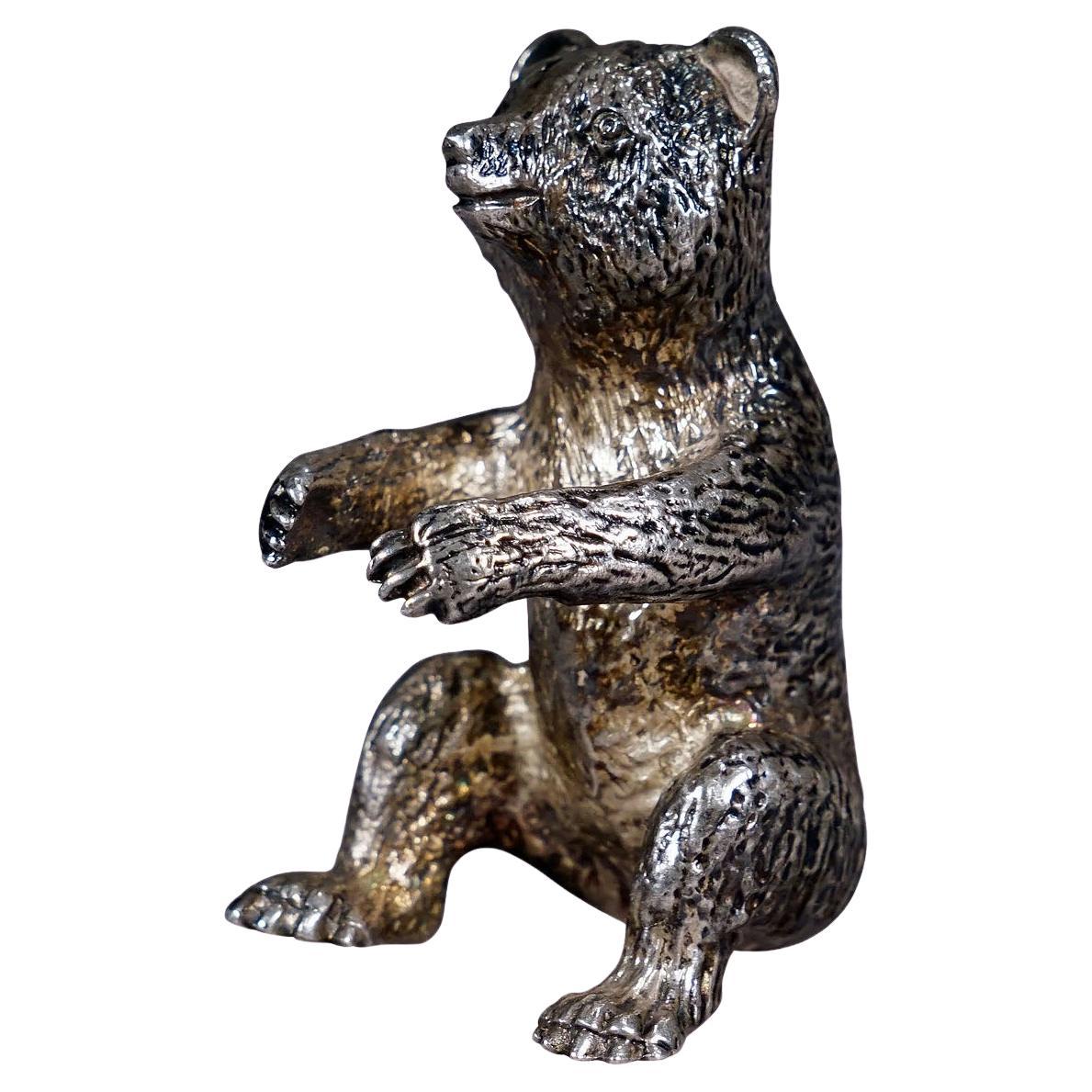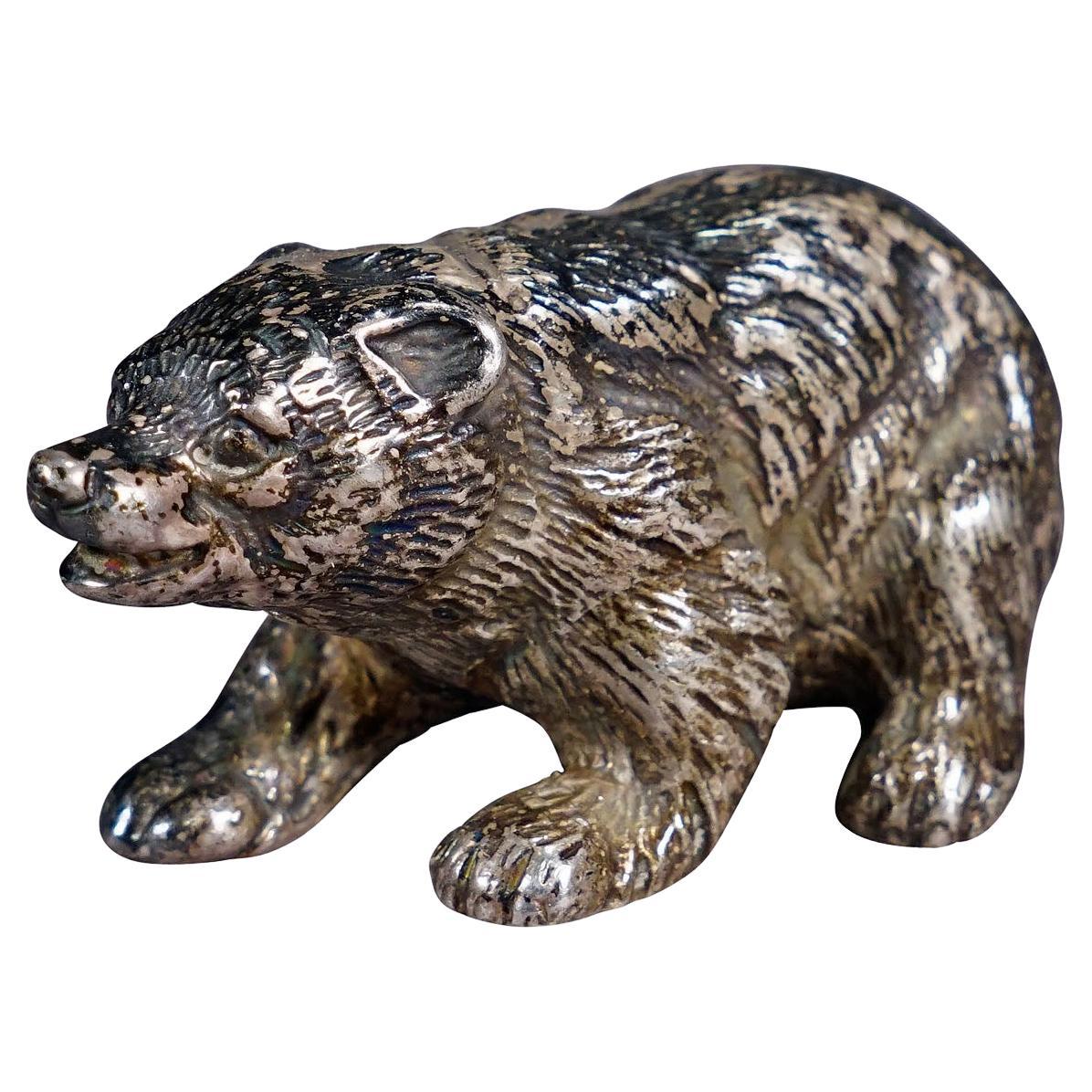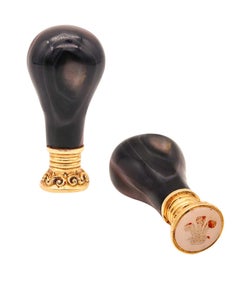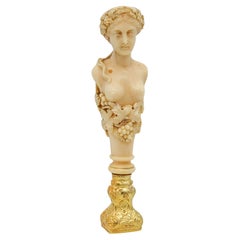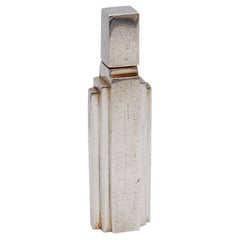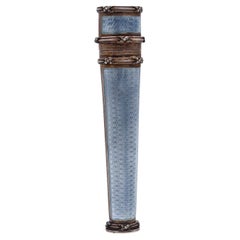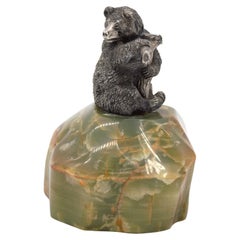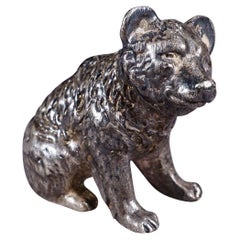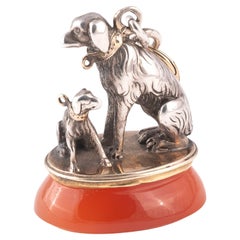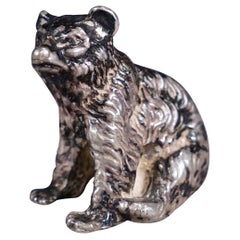Items Similar to Georg Adam Scheid 1910 Austria Desk Seal With Bear 900 Sterling Silver & Marble
Want more images or videos?
Request additional images or videos from the seller
1 of 6
Georg Adam Scheid 1910 Austria Desk Seal With Bear 900 Sterling Silver & Marble
$1,398
£1,061.34
€1,213.94
CA$1,953.21
A$2,172.39
CHF 1,134.36
MX$26,435.73
NOK 14,487.47
SEK 13,586.69
DKK 9,060.13
Shipping
Retrieving quote...The 1stDibs Promise:
Authenticity Guarantee,
Money-Back Guarantee,
24-Hour Cancellation
About the Item
An Austrian desk seal in marble and silver designed by Georg Adam Scheid.
Beautiful desk seal, created in Vienna Austria at the workshop of Georg Adam Scheid, back in the 1910-1915. Made up with carvings of white marble and parts crafted in solid .900/.999 sterling. Featuring on top the figure of a wild bear walking to the left and at the lower part the rounded seal, which is engraved with the monogram EH. The bear's head and the monogram are aligned as an indicator to properly stamp in the accurate position.
Weight: 52.5 Grams, (33.65 Dwt).
Measurements: 61 mm by 28 mm by 14 mm (2.40 x 1.10 x 0.55 Inches).
Hallmarks: Stamped with Austrian marks; the stamp for the city of Vienna, the maker's mark GAS associated to Georg Adam Scheid, the mark for the assay of the .900/.999 silver and the serial number 305. In addition some other unidentified enigmatic marks like a S-4, probably the silversmith.
Georg Adam Scheid
He was born in Schönau Baden, Württemberg on July 28 1837. He started his apprenticeship in 1853 and operated afterwards in Pforzheim and Stuttgart. In 1858 he came to Vienna and entered the workshop of the gold, silver goods producer and jeweler Michael Markowitsch. He married one of Markowitsch daughters and in 1862 the company was renamed Markowitsch & Scheid and adopted the mark M & S. It was located in Sandwirtgasse 8, and then in Gumpendorfer Straße 83. In 1882 they separated and Shied started his own flourishing operation, employing up to 300 workers. The silver decoration factory was named "G. A. Scheid" and used different marks. It was located in Gumpendorfer Straße 85. Markowitsch & Scheid was then owned by Adolf Markowitsch alone, a son of Michael Markowitsch, and kept the same mark, the company shut down in 1898. Specialties of Sheid's factory were cigarette cases, powder boxes, write sets, toilet sets as well as jewelry boxes, which were also sold in large quantities in Germany, France, Italy, Great Britain, Belgium and Spain. To ensure the supply of raw materials in 1888 Scheid opened up his own refinery where, from precious metal wastes, raw material as well as semi-manufactured products, as sheet metals and wires were produced. The operation grew rapidly and covered not only his own requirement but goods were also exported abroad and with the establishment of sister operations in Budapest (1891), Prague (1920) and Bucharest (1923) Scheid took control of the market. In 1894 the sons Arthur (1870-1897) and Robert (1872-1950), as well as his nephew George (1850-1937), stepped in as partners. In 1911 George Adam Scheid withdrew from the business life and Robert and Georg Scheid took over. Robert and his younger brother Ludwig (1886-1960) then assumed the management. After the First World War, fall of the overseas market for the decoration sector and the bad economic situation led, as a consequence, to the liquidation of the decoration factory, while the "Affinerie" continued and in 1962 merged with the Ludwig Roessler GmbH to form the ÖGUSSA GmbH, which still exists today.
Literature: Eric Schaling, George Adam Scheid, A Remarkable Viennese Silversmith, 2018. For similar objects illustrated.
Collateral: It is accompanied by a presentation jewelry pouch.
Condition: The overall condition of this piece is very good. Beside the little normal wear, there is no damage to the silver. All parts are secured in the settings. This piece has been carefully inspected to guarantee the condition and authenticity.
INVENTORY REF: D060823MCEJ/1.514
- Creator:
- Metal:
- Weight:52.3 g
- Dimensions:Height: 2.4 in (60.96 mm)Width: 0.55 in (13.97 mm)Length: 1.1 in (27.94 mm)
- Style:
- Place of Origin:
- Period:
- Date of Manufacture:1910
- Condition:Wear consistent with age and use. The overall condition of this piece is very good. Beside the little normal wear, there is no damage to the silver. All parts are secured in the settings. This piece has been carefully inspected to guarantee the condition and authenticity.
- Seller Location:Miami, FL
- Reference Number:Seller: D060823MCEJ/1.5141stDibs: LU2690220038472
About the Seller
5.0
Recognized Seller
These prestigious sellers are industry leaders and represent the highest echelon for item quality and design.
Platinum Seller
Premium sellers with a 4.7+ rating and 24-hour response times
Established in 1995
1stDibs seller since 2022
914 sales on 1stDibs
Typical response time: <1 hour
- ShippingRetrieving quote...Shipping from: Miami, FL
- Return Policy
Authenticity Guarantee
In the unlikely event there’s an issue with an item’s authenticity, contact us within 1 year for a full refund. DetailsMoney-Back Guarantee
If your item is not as described, is damaged in transit, or does not arrive, contact us within 7 days for a full refund. Details24-Hour Cancellation
You have a 24-hour grace period in which to reconsider your purchase, with no questions asked.Vetted Professional Sellers
Our world-class sellers must adhere to strict standards for service and quality, maintaining the integrity of our listings.Price-Match Guarantee
If you find that a seller listed the same item for a lower price elsewhere, we’ll match it.Trusted Global Delivery
Our best-in-class carrier network provides specialized shipping options worldwide, including custom delivery.More From This Seller
View AllEdwardian 1900 Agate Desk Seal In 18Kt Gold With The Arms of The Prince of Wales
Located in Miami, FL
Desk seal with the arms of the Prince of Wales.
Very rare and unusual desk seal, created in England during the Edwardian period, back in the early 1900's. This seal feature the arms of the Prince of Wales and is composed by the agate pommel, carved with smooth surfaces and the round mount setting crafted in yellow gold of 18 karats with scrolls decorations. The seal depicts three feathers aligned over a crown, carved with incised intaglio in natural white agate.
Gemstones: The handle pommel is carved from a single piece of brown translucent agate with bluish veins.
Weight: 14.95 Grams, (9.58 Dwt).
Measurements: 41 mm by 19 mm (1.61 x 0.75 Inches).
Hallmarks: No marks, electronically tested for 18 karats gold.
Arms of Prince of Wales
The Prince of Wales's feathers – Almost History
The coat of arms of the Prince of Wales is the official personal heraldic insignia of the Princes of Wales, a title traditionally granted to the heir apparent of the reigning monarch of the United Kingdom of Great Britain and Northern Ireland, formerly the Kingdom of Great Britain and before that the Kingdom of England. Since Edward I awarded it to his son the future Edward II, the heir apparent to the English throne has been created with the title Prince of Wales. The history of the coat of arms is closely linked with those of the Royal coat of arms of England and the Royal coat of arms of the United Kingdom. However, as the noted antiquarian and heraldist Charles Boutell wrote in 1863, "The Arms of the Prince of Wales have a distinct individuality of their own, with which nothing ought to be directly associated".
History
The badge has no connection with the native Princes of Wales. Its use is generally traced back to Edward, the Black Prince (1330–1376), eldest son and heir apparent of Edward III of England. Edward bore (as an alternative to his differenced royal arms) a shield of Sable, three ostrich feathers argent, described as his "shield for peace", probably meaning the shield he used for jousting. These arms can be seen several times on his chest tomb in Canterbury Cathedral, alternating with his royal arms (the royal arms of King Edward III...
Category
Antique Early 1900s English Edwardian Desk Accessories
Materials
Agate, Gold, 18k Gold, Yellow Gold
$3,188 Sale Price
20% Off
Free Shipping
French 1798 Neo Classic Stamp Seal in 18kt Gilded Silver with Carved Bust Flora
Located in Miami, FL
French neo classic desk seal.
Wonderful desk seal, created in France during the late 18th century, back in the 1798-1808. This magnificent piece of art was conceived as a miniature sculpture mounted in a Louis XVI neoclassical style base. This base is crafted in 18 karats gold over silver with chiseled and incised decorations, supporting a magnificent extremely detailed carving of a women. The carved piece, depicts, the naked portrait bust of the classical Greek-Roman goddess of the flowers and nature Flora (Heba), facing forward and exhibiting her breasts, undressed and crowned with flowers, wheat and ivy.
Flora or Heba
She was the deity of the flowering plants, fertility, spring, and blossoming. Although she was a minor figure compared to other goddesses of the Roman empire, she was important as a fertility goddess. Flora was responsible for the abundance of the crops in spring, so her worship strengthened as this season approached. Her name derives from the Latin floris, which means flower, and her Greek counterpart was the nymph, Chloris. The Sabine King Titus Tatius introduced Flora into the Roman pantheon...
Category
Antique 1790s French Neoclassical Desk Accessories
Materials
Gold, 18k Gold, Silver
$3,028 Sale Price
20% Off
Free Shipping
Jean Louis Scherrer Art Deco Skyscraper Perfume Bottle in .925 Sterling Silver
By Jean-Louis Scherrer
Located in Miami, FL
Perfume bottle designed by Jean-Louis Scherrer.
Very rare and beautiful perfume bottle, created in Paris France by Jean Louis Scherrer, back in the late 20th century. This exotic perfume bottle was made as a promotion for the launching of his famous Scherrer 2 perfume in 1986. Carefully crafted in the art deco style with skyscraper patterns, in solid sterling silver of .925/.999 with high polished finish. Fitted with a lid and a pistil to applicate the perfume and scents.
Weight: 130.95 Grams, (83.94 Dwt).
Measurements: 86 mm by 24 mm by 18 mm (3.40 x 0.94 x 0.71 Inches).
Hallmarks: Stamped with French marks, the silver assay mark, the maker's mark of SF inside a lozange cartouche, the edition number and signed, "JEAN LOUIS SCHERRER PARIS 925 Sterling #0202"
Edition: Number 0202 from 1000 pieces produced.
Jean-Louis Scherrer born in Paris in February. He was a Parisian fashion designer and couturier. Although he had name recognition and was known for his work, he is mainly noted for being the first couture designer to be sacked from their own-name label in 1992. Scherrer trained as a dancer at the Conservatoire de Paris until he injured his back, which put him out of action for three months. He then decided to focus on fashion design, and in 1956, joined Christian Dior as an assistant designer alongside Yves Saint Laurent. Following Dior's death in 1957, Scherrer worked under Saint Laurent, and then for Louis Féraud, before launching his own fashion house in 1962 on the Rue du Faubourg Saint-Honoré with the backing of Jacques Chabrol, a French millionaire. In the mid-1960s Scherrer had an agreement with the American department store Bergdorf Goodman to grant them exclusive rights to reproduce and resell his designs in the United States. His clients included Anne-Aymone Giscard d'Estaing, Jacqueline Kennedy Onassis, and Raquel Welch, who wore Scherrer animal-print dresses in the 1977 film L'Animal. By the 1980s, his work was known for its opulence and luxury, with many garments hand-beaded, embroidered and lavishly trimmed. His extremely expensive designs were popular with the wealthy wives of Middle East oil tycoons, but after the Gulf War...
Category
Late 20th Century French Art Deco Vanity Items
Materials
Silver, Sterling Silver
$980 Sale Price
20% Off
Free Shipping
French 1890 Etui Sealing Wax Case Guilloche Blue Enamel in Sterling Silver
Located in Miami, FL
French etui sealing wax case.
Exquisite objet d'art, created in Paris France in the late 19th century, circa 1890. This is a etui sealing wax case, master...
Category
Antique 1890s French Neoclassical Boxes and Cases
Materials
Diamond, White Diamond, Silver, Sterling Silver, Enamel
$3,960 Sale Price
20% Off
Free Shipping
Austrian 1900 Vienna Agate Vesta Box In 18Kt Yellow Gold With Carved Essex Glass
Located in Miami, FL
An Austrian agate vesta box with Essex glass.
Gorgeous vesta matches box, created during the Edwardian Period in Vienna Austria, circa 1900. Made up in two parts carved from natura...
Category
Antique Early 1900s Austrian Edwardian Desk Accessories
Materials
Agate, Gold, 18k Gold, Yellow Gold, Enamel
$3,988 Sale Price
20% Off
Free Shipping
British 1930 Art Deco Enamelled Guilloche Vinaigrette Box In 925 Sterling Silver
Located in Miami, FL
Art deco enamel vinaigrette box.
Beautiful vinaigrette case, created in London England back in the 1930. This stunning piece has been crafted in a a r...
Category
Vintage 1930s English Art Deco Boxes and Cases
Materials
Silver, Sterling Silver, Enamel
$718 Sale Price
20% Off
Free Shipping
You May Also Like
Antique rare amusing Russian silver model of a bear, St Petersburg, circa 1890
Located in Tel Aviv - Jaffa, IL
Antique 19th Century rare Imperial Russian solid silver statue depicting a bear sitting and Hogging a tree stump, heavy cast and engraved to the last detail. Hallmarked Russian Silver 84 (875 standard), St Petersburg, Maker Alexander Lokin.
This rare find is an amazing example of Russian imperial silver works, mostly made for Royalty in Russia or exporting to other wealthy families and individuals in all of Europe.
The base of this silver bear is hand carved from a massive single piece of green onyx, shaped as A Boulder. Great desk ornament or an amazing addition to any important antique silver Collection
Measurements :
Height : 5.9 inch / 15 cm
Width : 4.8 inch / 12 cm
Condition :
Perfect condition to its age, no brakes, no restorations,
Some minor scratches and age related wear.
Russian lapidary work (of the onyx base) :
The hand carved green onyx base of this sculpture is designed as A naturalistic but also Modernistic boulder, with its smooth lines its a perfect example of The late 19th century Lapidary works made in Russia. during the second half of the 19th Century, demand grew For copies of the many treasures admired by visitors on the Northern Grand Tour, which Included Russia. So shops and Galleries sprung up on the Nevsky Prospect, St Petersburg, to serve these new and wealthy visiting customers. At The same time an Influx of Italian craftsmen brought with them new skills and techniques Which they used To maximise the beauty of these hardstone objects...
Category
Antique 1890s Russian Sterling Silver
Materials
Onyx, Silver
Cast of a Sitting Bear Sterling Silver ca. 1930s
Located in Berghuelen, DE
Cast of a Sitting Bear Sterling Silver ca. 1930s
Item e7247
A lovely sculpture of a sitting bear casted in sterling silver, Germany 1st half of the 20th century. 75,9 gramm, 2.68 oz....
Category
Early 20th Century German Victorian Sterling Silver
Materials
Silver
A Large Silver Gold And Hardstone Fob Seal English Circa 1870
Located in Firenze, IT
The urn-shaped handle and cast and chased with two sporting dogs , the carnelian matrix without engraved.
English, circa 1870
Height 3cm
Weight: 14.40gr.
Category
Antique Late 19th Century British Victorian Figurines and Sculptures
Materials
Carnelian, Silver, Gold
Tiny Sterling Cast of a Sitting Bear
Located in Berghuelen, DE
Tiny Sterling Cast of a Sitting Bear
Item e7246
A lovely sculpture of a sitting bear casted in sterling silver, Germany 1st half of the 20th century. 17,1 gramm, 0,60 oz. A wonderful...
Category
Early 20th Century German Victorian Sterling Silver
Materials
Silver
Cast of a Sitting Bear Sterling Silver ca. 1930s
Located in Berghuelen, DE
Cast of a Sitting Bear Sterling Silver ca. 1930s
Item e7245
A lovely sculpture of a sitting bear casted in sterling silver, Germany 1st half of the 20th century. 57,3 gramm, 2.02 oz....
Category
Early 20th Century German Victorian Sterling Silver
Materials
Silver
Vintage Sterling Sculpture of a Strolling Bear
Located in Berghuelen, DE
Vintage Sterling Sculpture of a Strolling Bear
Item e7250
Small sculpture of a strolling bear in sterling silver, cast in Germany in the 1st half of the 20th century. 42.4 gramm, 1.4...
Category
Early 20th Century German Victorian Sterling Silver
Materials
Silver
More Ways To Browse
Antique Silver 900
Austrian Silver Jewellery
1923 Jewelry
Art Deco Austrian Jewelry
Jewelry From 1962
900 Silver Jewelry
Antique Semi Precious Jewellery
Spanish Art Deco Jewelry
Sterling Silver With M Monogram
Italian Cigarette Case
Metal Cigarette Case
Antique Silver Powder Box
Michael Good Jewelry
Toilet Art Deco
Gold Toilet
Marble Cigarette
Austrian Cigarette Case
Cigarette Case 1960s
